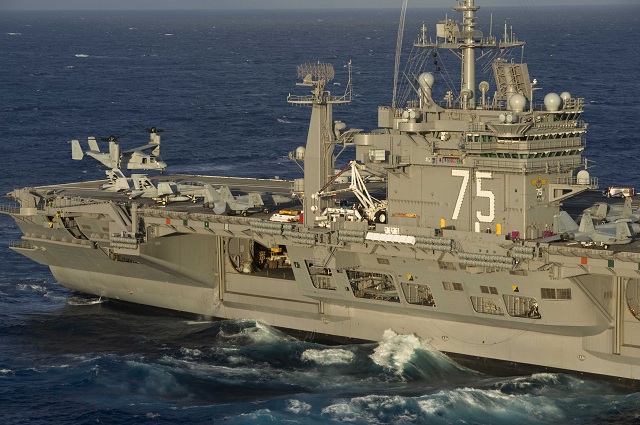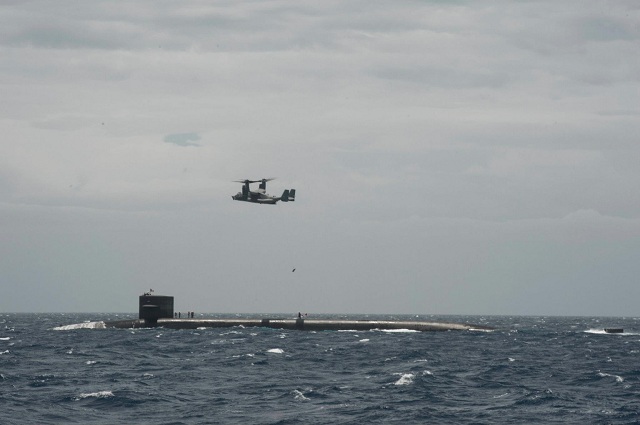|
|
| a |
Naval
Forces News - USA |
| |
|
| |
| |
| V-22
Osprey supports Harry S. Truman aircraft carrier flight deck certification |
| |
When a V-22 Osprey from Marine Tiltrotor Operational Test and Evaluation
Squadron (VMX) 22 landed for the first time on USS Harry S. Truman (CVN
75) on July 19, it highlighted another in a series of firsts for the
unique tilt-rotor aircraft that has become an integral part of the U.S.
naval forces.
And although the July 19 landing was a first for a V-22 on Truman, it
wasn’t the first time for an aircraft carrier, nor, according
to Cmdr. Sean McDermott, the V-22 Joint Program Office (PMA-275) Navy
integrated production team lead, will it be the last.
“The Marine Corps has committed to providing V-22s to support
CVN flight deck certifications,” McDermott said, adding that one
of the goals of Navy leadership is to incorporate V-22s into the aircraft-carrier
flight-deck certification process as often as possible.
“It won’t be long before each carrier has had V-22s on board,”
he said. |
|

An MV-22 Osprey assigned to the Argonauts of Marine Tiltrotor Operational
Test and Evaluation Squadron (VMX) 22 lands on the flight deck of the
aircraft carrier USS Harry S. Truman (CVN 75) on July 19. This is Truman's
first Osprey recovery. Truman is underway conducting carrier qualifications.
(U.S. Navy photo)
|
|
In March, Ospreys supported flight-deck certification
with USS George H.W. Bush (CVN 77) and returned to the ship two months
later to perform dynamic interface testing to gather data to expand
the V-22’s current flight envelope, McDermott said.
In addition to this past spring’s CVN integration operations,
McDermott said a V-22 recently played a role in a deployed aircraft
carrier’s logistics mission.
“In July, USS Abraham Lincoln (CVN 72) was operating in the Arabian
Sea and had about 3,000 pounds of perishable goods needing to be delivered
to USS Iwo Jima (LHD 7),” McDermott said. “(Iwo Jima) was
about 250 nautical miles away from the Lincoln and helicopters couldn’t
travel to Iwo in the appropriate amount of time, so they requested a
V-22 from the Marines on the Iwo Jima.”
The Osprey, from Medium Tiltrotor Squadron 261 (VMM-261), landed on
Lincoln, loaded the cargo and six passengers and was airborne in less
than 25 minutes. A fairly routine mission, but noteworthy because it
involved a carrier, McDermott said.
“V-22s provide support for the MEU (Marine Expeditionary Unit)
and amphibious warships all of the time, this logistics mission only
scratches the surface of the aircraft’s potential for the U.S.
Navy.”
|
|
 A V-22 Osprey from Air Force Special Operations Command prepares to
perform a proof of concept for personnel evacuation from the Ohio-class
ballistic missile submarine USS Wyoming (SSBN 742) on June 6. Wyoming
is at sea performing routine operations.
A V-22 Osprey from Air Force Special Operations Command prepares to
perform a proof of concept for personnel evacuation from the Ohio-class
ballistic missile submarine USS Wyoming (SSBN 742) on June 6. Wyoming
is at sea performing routine operations.
(U.S. Navy photo)
|
|
In addition to this logistics support function, the
V-22 is also uniquely suited for the medevac mission, McDermott said.
This was shown in June, when an Air Force V-22 successfully demonstrated
an evacuation from an Ohio-class ballistic missile submarine off the
southeast coast of the United States.
The V-22 traveled from Cannon Air Force Base, N.M., to the surfaced
submarine USS Wyoming (SSBN 742), a distance of more than 1,300 miles.
While hovering above the submarine, the aircraft lowered a hoist line
and simulated evacuating a submarine crewman strapped into a Stokes
rescue stretcher. The Osprey then returned to its base in New Mexico.
"It was a pretty awesome experience," said Air Force Capt.
William Thompson, the V-22 pilot who flew the mission. "It really
is a great aircraft, versatile, flexible and a blast to fly." Thompson
is a member of the 20th Special Operations Squadron, part of the 27th
Special Operations Group at Cannon.
“This medevac demonstration was just one example of the myriad
missions the V-22 is capable of completing,” said Marine Col.
Greg Masiello, head of the V-22 Joint Program Office at Naval Air Systems
Command.
"[June 6th’s evolution] demonstrated one of the unique capabilities
the Osprey brings to a commander's playbook -- the ability to go farther,
faster and safer than any other medevac vertical takeoff and landing
(VTOL) aircraft,” Masiello said. “These capabilities can
and will be instrumental in saving lives.”
A fact not lost on Wyoming’s commanding officer.
“It’s nice to know the U.S. Navy, working with our joint
partners, has the capability to rapidly evacuate critically injured
Sailors without negatively impacting the strategic mission,” said
Cmdr. Chris Nash, USS Wyoming’s commanding officer.
While some of the details and location of the June 6 demonstration are
classified, Nash said he was impressed that in spite of wind gusts of
30 knots and heavy seas, the Osprey remained stable above the submarine,
without so much as a shiver from the wind.
“This was excellent training for my Sailors,” Nash said.
“[This evolution] highlighted the unique capabilities of this
transformational aircraft and proved synergy possible when leveraging
two of the most capable platforms in the Joint Forces.”
From: Naval Air Systems Command
|